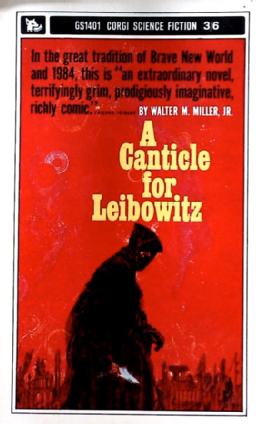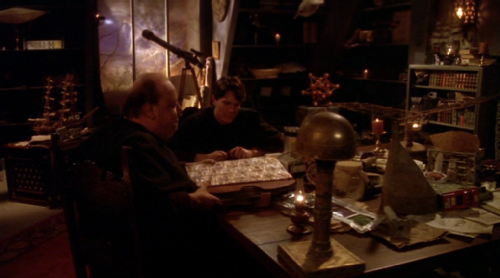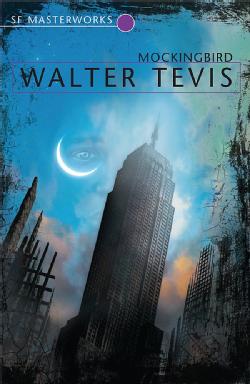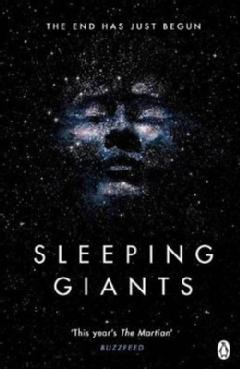Religion and the Preservation of Knowledge in SF
In the early Middle Ages, a literate Roman urban culture in England had been superseded by the more dispersed Anglo-Saxon society, with its preference for oral histories. Much of the written culture of earlier civilisations was known and conserved only in the rare institutions where Latin was spoken and written: primarily the monasteries. As a result, the Catholic church became associated with preservation of knowledge - not only of received religious insights, but also historical and factual information. This positioning was perhaps most extreme in the British Isles, but can also be found across Europe following the withdrawal of the Roman Empire and the rise of Christianity. The role of the church in shaping both early-modern culture and the first glimmerings of modern science was profound. Perhaps unsurprisingly then, the role of organised religion in the preservation of knowledge across extended time periods has been explored in the science fiction of religious futurisms.
After the Fall
One common trope in religious SF perhaps most closely mirrors the situation in Medieval Europe: the role of religious orders in preserving knowledge in post-apocalyptic scenarios which explore the aftermath of a civilisation collapse.
 Amongst the most famous examples in this field is Walter M Miller’s 1959 novel A Canticle for Leibowitz. In this story, the eponymous Leibowitz is a technician who attempts to collect scientific texts which are being destroyed by a distressed population after a nuclear apocalypse: the Flame Deluge. Spanning many centuries, the novel follows a religious cult within the Catholic Church as it tries to secure canonisation for its patron and preserve the knowledge through the descent and rebuilding of the civilization. The novel recognises two key principles here: the survival potential of an established religion in the face of societal change, and the fact that in the long-term preservation is sometimes more important than understanding. Miller’s monks themselves pass through intervals of ignorance:
Amongst the most famous examples in this field is Walter M Miller’s 1959 novel A Canticle for Leibowitz. In this story, the eponymous Leibowitz is a technician who attempts to collect scientific texts which are being destroyed by a distressed population after a nuclear apocalypse: the Flame Deluge. Spanning many centuries, the novel follows a religious cult within the Catholic Church as it tries to secure canonisation for its patron and preserve the knowledge through the descent and rebuilding of the civilization. The novel recognises two key principles here: the survival potential of an established religion in the face of societal change, and the fact that in the long-term preservation is sometimes more important than understanding. Miller’s monks themselves pass through intervals of ignorance:
“Still, such knowledge had a symbolic structure that was peculiar to itself, and at least the symbol-interplay could be observed. To observe the way a knowledge-system is knit together is to learn at least a minimum knowledge-of-knowledge, until someday - someday or some century - an Integrator would come, and things would be fitted together again.” (Corgi paperback edition, 1963, pg 55)
It should be noted that this process is not without its problems in Miller’s future. Inevitable human nature results in losses and repeated mistakes. Information becomes distorted, as do the motives and priorities of the religious order. Nonetheless, more than a thousand years after the Flame Deluge, the Leibowitz order survives and helps lead a resurgent civilisation towards scientific discoveries in a plausible and convincing narrative.
 A very similar scenario was strikingly captured by television series Babylon 5 in its grand sweep through a million years of future history in the episode “The Deconstruction of Falling Stars” (1997). Five hundred years after a nuclear exchange, two monks discuss their faith, their history and their hope of rebuilding civilisation. Again, the monastic institutions of the Catholic Church are used as a repository of secret learning following the collapse of civilisation, although whether the order is truly answerable to the papacy or merely adopting the forms is left unclear. Both the resources of the church and its authority (including moral authority and the relative protection associated with it) are leveraged to support the preservation of a knowledge when other institutes of learning have failed. As the image shows, the mise-en-scene in this vignette invoked the work of early modern scientists, with the dome of a van der Graff generator, a telescope, models of airships and a framework model of a glider all visible, together with books containing both factual knowledge and history rendered as holy writ.
A very similar scenario was strikingly captured by television series Babylon 5 in its grand sweep through a million years of future history in the episode “The Deconstruction of Falling Stars” (1997). Five hundred years after a nuclear exchange, two monks discuss their faith, their history and their hope of rebuilding civilisation. Again, the monastic institutions of the Catholic Church are used as a repository of secret learning following the collapse of civilisation, although whether the order is truly answerable to the papacy or merely adopting the forms is left unclear. Both the resources of the church and its authority (including moral authority and the relative protection associated with it) are leveraged to support the preservation of a knowledge when other institutes of learning have failed. As the image shows, the mise-en-scene in this vignette invoked the work of early modern scientists, with the dome of a van der Graff generator, a telescope, models of airships and a framework model of a glider all visible, together with books containing both factual knowledge and history rendered as holy writ.
Writer J. Michael Straczynski has been quoted as recognising the echos of A Canticle for Leibowitz after he had written the vignette, although apparently not consciously inspired by them. As he has pointed out religious themes, including monastic orders and the quasi-religious "Rangers", had featured earlier in the Babylon 5 narrative, leading in a natural progression towards the scenario played out in "Deconstruction of Falling Stars". Indeed an underlying theme of this episode was the importance of faith - in individuals, moral tenants and in the ultimate attainment of one’s goals. This was highlighted by a dedication text on the episode which concluded “Faith manages", and in the dialogue: one of the two monks in the post-apocalyptic scene describes faith and reason as "the shoes on your feet. You can travel further with both than you can with just one". Hence the leverage of faith in the protection of knowledge is a natural continuation of the same theme.
Moving away from the established Catholic church of western Europe, an interesting example of its structures being reimagined for an alien world can be found in Isaac Asimov’s 1941 science fiction story “Nightfall” (subsequently reworked into a novel cowritten by Robert Silverberg, 1990). This imagines a very different world - a planet in a sextuple star system, in which naturally-occurring darkness is effectively unknown outside of deep caves. As a result, an eclipse phenomenon which occurs only once every 2500 years finds a population psychologically unable to deal with a lack of light, and results in cyclic collapse of civilizations.
While the story focuses on the efforts of scientists to identify and record the disaster, an important role is played by a religious cult whose secret knowledge is preserved from earlier cycles. Here we see the strength of a faith system in preserving information over an extended time period and its problems: the purpose of preserving knowledge has become warped and distorted. What might originally have been intended as a library has become regarded as a divine truth to be shared only with initiates. Volition and purpose has been assigned to the phenomena associated with the collapse, and as a result, the cult resists attempts to scientifically explain or predict the current cycle as counter to the will of deity. The cult characters who appear act as an explicitly anti-scientific force, and thus the story presents the contradiction of an organisation with long-term stability that enables knowledge from previous cycles to be preserved, but exists in parallel with tenets of faith which will restrict the knowledge available to future cycles.
Asimov returned to the idea of religion as a tool for the preservation of knowledge in his epic Foundation series (starting 1951). Early in the history of the series, Galactic civilisation collapses and the titular Foundation maintains a hegemony over adjacent planets by providing technology but wrapping it in the trappings of religion. While the core of true knowledge is preserved on the Foundation's homeworld, on the planets under its influence, cancer-treating medicines are reduced to "Holy Food" and the only place to receive training in its use is at the Foundation. As one of the characters notes: "when the old Empire began to rot at the fringes, it could be considered that science, as science, had failed the outer worlds. To be reaccepted it would have to present itself in another guise - and it has done just that" (Panther edition, 1976, pg 76). So again we see religion used to restrict knowledge and sometimes to distort it, at the same time as to preserve it.
The Dangers of Orthodoxy
This conflict, which is explored in places in A Canticle for Leibowitz and made explicit in Nightfall, echoes a much older narrative which places religion in conflict with science. A natural consequence of the preservation of learning in the religious institutions of Medieval Europe was that the first steps towards inquiry-led discovery, and ultimately modern science, were often taken within those institutions. Many early-modern scientists, amongst them Albertus Magnus, Robert Grossteste, Roger Bacon, Georges Lemaitre and Gregor Mendel, were catholic chuchmen. However many of these faced censure from religious authorities as their investigations or conclusions were deemed to challenge religious orthodoxy. Inquiry itself is seldom prohibited by religious texts, and modern churches are often supportive of scientific research. However the premise that received wisdom is infallible and unchanging conflicts with the core tenets of scientific method, in which received understanding is robustly challenged until counter evidence is identified, in the hope that this may provide insight into the underlying principles.
Thus those seeking evidence to challenge theories may be accused of heresy. In this context, the preservation of ancient knowledge can be threatened by ethically-motivated, but problematic, attempts to protect future generations from corrupting influences. Human history presents us with examples of such "protective" knowledge destruction by organised religion, such as the Bonfire of the Vanities (in fifteenth century Italy) or the destruction of museum collections by the Taliban (in twenty-first century Iraq). On the other hand, it also presents us with counter-examples of the defences of ancient knowledge, such as Thomas Aquinas’s championing of Aristotle (thirteenth century Italy) and the preservation of classical learning at the medieval Caliphate courts of the Middle East.
Religion plays this complex and evolving role in other science fiction examples. John Wyndham’s novel The Chrysalids (1955) provides another post-apocalyptic example where the effects of a nuclear apocalypse has been incorporated into the forms of the christian church. To the young protagonist David, the church is an oppressive force and a personal threat. To other eyes, the emphasis on genetic purity and destruction of mutations which has become incorporated into its worship might actually be seen as positive: in a radiation-rich environment, preserving the safety and edibility of foodstuffs would necessarily be a priority. If religious writ is required to ensure stable crop supply when the scientific motivation is lost, then so be it. Where this premise goes astray is again in religion’s demand for absolute truths: in banishing or destroying all genetic differences, this society is unable to recognise the existence of beneficial mutations or face its own culpability for the suffering of those rejected.
 In the novel Mockingbird (Walter Tevis, 1980), the main character’s journey through a post-apocalyptic wasteland pauses in a small community which inhabits a long-abandoned shopping mall. In this culture, “when literacy had died, so had history” (Gollanz Masterworks edition, pg 161), and the protagonist is one of very few able to read. He becomes Reader (a form of priest) to the community due to his ability to understand the Bible. Religion here is not a monolithic and overpowering organisation but instead a small scale sect, led by the patriarch of a family clan. In this context religion forms a kind of social glue, ensuring respect for the needs of the community, but is also shown to be oppressive and - importantly - only half-understood by its adherents:
In the novel Mockingbird (Walter Tevis, 1980), the main character’s journey through a post-apocalyptic wasteland pauses in a small community which inhabits a long-abandoned shopping mall. In this culture, “when literacy had died, so had history” (Gollanz Masterworks edition, pg 161), and the protagonist is one of very few able to read. He becomes Reader (a form of priest) to the community due to his ability to understand the Bible. Religion here is not a monolithic and overpowering organisation but instead a small scale sect, led by the patriarch of a family clan. In this context religion forms a kind of social glue, ensuring respect for the needs of the community, but is also shown to be oppressive and - importantly - only half-understood by its adherents:
“They were willing to accept their stringent piety, and silence, and sexual restraints, all unthinkingly, along with a few platitudes about Mary and Jesus and Noah; they were overwhelmed, however, at the effort it would require to understand the literature that was the real source of their religion” (pg 227).
In fact, their primary text is a Reader’s Digest (i.e. heavily abbreviated or simplified) version of the Bible, and it’s clear that here (as was also the case in The Chrysalids) knowledge is being distorted over the span of a few generations, let alone over millennia.
This distortion and the way that aspects of religion can warp any knowledge it attempts to preserve is also a major theme in the Hyperion Cantos (novel series, Simmons, 1989-1997). Here, the future of the Catholic Church is considered in the context of a human diaspora through the Galaxy. Across four lengthy books, the church shifts from being a minor, disregarded, anachronism to a major interstellar force, at least in part because the message of the church becomes distorted by a physical “resurrection” provided by an alien life-form. The personal history of key characters becomes distorted as a result. The Hyperion Cantos are complex books, with rich philosophical themes, framed through the personal journeys of key individuals. Knowledge preservation through time is not the central motif, but the novel series echoes the questions regarding truth versus dogma, and history versus mythologising, that are also seen in the examples mentioned above.
Aliens Amongst Us
The texts mentioned above have in common their extrapolation of the Catholic Church, or of structures which closely mirror it. However, a consideration of knowledge preservation through religion is not complete without looking at a significant counter-factual trope in science fiction.
The pseudo-historical bestseller Chariots of the Gods (von Daniken, 1968) popularised the idea that ancient religions, primarily those of now-defunct civilisations such as the Egyptians or the cultures of Meso-America, preserve a record of alien contact. While there are too many flaws in this premise to discuss here, its impact on science fiction has been significant.
 Popular examples including the Stargate (movie 1994, multiple television series 1997-2018) and Marvel franchises (notably the character Thor, first appearing in comic form in 1962) both of which position Norse and Egyptian religious mythology as retained historical memories of alien contact, with alien entities embodying the ancient gods. Another entry in the same subgenre can be found in the Battlestar Galactica franchise (1978 onwards) in which Egyptian culture, Greek mythology, and modern astrology in the form of the zodiac is shown to preserve echoes of a past extraterrestrial origin for humanity. In addition, and particularly in the reimagined television series (2004-2009), religion plays an internal narrative role - the half-forgotten knowledge preserved in the religious texts of a refugee population guide their journey towards an ancestral homeworld.
Popular examples including the Stargate (movie 1994, multiple television series 1997-2018) and Marvel franchises (notably the character Thor, first appearing in comic form in 1962) both of which position Norse and Egyptian religious mythology as retained historical memories of alien contact, with alien entities embodying the ancient gods. Another entry in the same subgenre can be found in the Battlestar Galactica franchise (1978 onwards) in which Egyptian culture, Greek mythology, and modern astrology in the form of the zodiac is shown to preserve echoes of a past extraterrestrial origin for humanity. In addition, and particularly in the reimagined television series (2004-2009), religion plays an internal narrative role - the half-forgotten knowledge preserved in the religious texts of a refugee population guide their journey towards an ancestral homeworld.
A more recent science fiction example of ancient alien visitation memories encoded in religious texts can be found in the Themis Files of Canadian novelist Sylvain Neuvel. Across three novels (Sleeping Giants, Waking Gods and Only Human, 2016-2018), Neuvel unpacks the biblical account of giants walking the Earth - again attributing it to a factual alien incursion in the distant past. Neuvel’s work does not explore the role of religion in detail and is primarily secular in its approach, but is notable for viewing such a discovery from a modern and technological perspective, weaving complex narrative and character development through the science fiction themes it explores.
Inevitably, this is only a quick look through examples of religious futurism, rather than a full exploration of the genre. Nonetheless, it is interesting to see the recurrent themes - religion as a source of stability and authority in a changing world, the potential of that authority to preserve knowledge, and the risk of corruption or censorship which accompanies it - and to trace them back to our own medieval past. To what extent the structures of contemporary organised religion will survive into the future, as some writers of the last century believed inevitable, is unclear. Once-widespread religions such as Mithraism have died in the past, sometimes long before the civilisations which gave rise to them. Others have accompanied their originators in a descent to obscurity and extinction. Which of those will apply to christianity, islam and the other world religions of today is yet to be seen. Despite the rise of humanism and the decline in church attendance in recent decades, the current established Church is perhaps unlikely to disappear while its structures and resources remain strong - and it is likely still a safe bet when it comes to preserving records as we look forwards into the sweep of history.
"Religion and the Preservation of Knowledge in SF", Elizabeth Stanway, Cosmic Stories blog, 22nd August 2021
